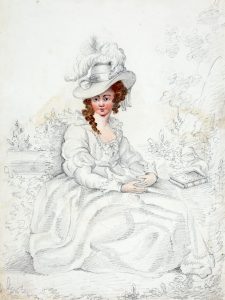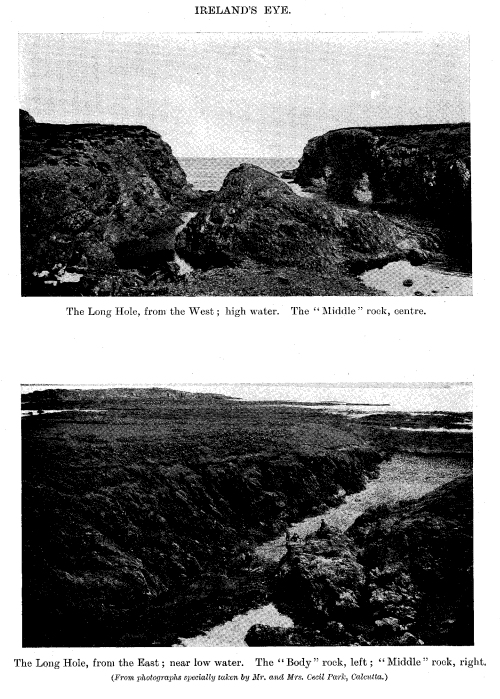March marks the annual immersion into Irish culture—sipping on beer, sporting various shades of green, and relishing a hearty corned beef and cabbage dinner. Today, let’s shift our focus as we leverage HeinOnline’s World Trials Library to unlock a notorious murder trial from Ireland, one that had the country divided.
A Day At Sea
On September 6, 1852, the picturesque scene of William Burke Kirwan and his wife of 12 years, Sarah Maria Louisa Kirwan, embarking on a fisherman’s boat marked the beginning of a tale steeped in mystery and darkness. William, an avid artist, carried a bag of art supplies as they set off with fisherman Patrick Nangle towards Ireland’s Eye, a small, long-uninhabited island near Howth, Dublin.[1]M. McDonnell Bodkin. Famous Irish Trials (1918). This document can be found in HeinOnline’s World Trials Library.
The day unfolded peacefully, as William painted the island’s landscapes while Sarah reveled in the sun and the sea. However, as the clock neared 8 pm, the agreed-upon time for Nangle to pick them up, the couple’s idyllic day took a chilling turn. Nangle and his cousin returned to the island, expecting to find the Kirwans, but only William stood there, his wife mysteriously absent.[2]William Roughead. What Is Your Verdict (1931). This document can be found in HeinOnline’s World Trials Library.

A search ensued, anxiety mounting with each passing moment. William insisted Sarah had found a different spot to swim, but the island yielded no trace of her. It was Nangle who discovered a haunting sight on the rocks below–Sarah’s lifeless form. Her bathing suit bunched up, exposing her body to the elements, and her hair entangled with seaweed and rocks. Blood marked her face, breasts, and ears. Although her body was still warm, she was foaming at the mouth.

Nangle and his cousin decided to bring the boat around to the body, leaving William alone, sprawled over his deceased wife. Upon returning to Howth, Sarah’s lifeless form was transported to her room. William, consumed by an unsettling urgency, commanded a nurse on-site to cleanse Sarah’s body.[3]William Roughead. Fatal Countess and Other Studies (1924). This document can be found in HeinOnline’s World Trials Library. Despite the nurse’s cautious reminder that the police might frown upon tampering with the body, William remained steadfast in his insistence.
The following day, a medical student’s examination concluded that Sarah had drowned, with no signs of foul play evident. However, as whispers among the nurses who cleaned her body spread, authorities sensed a need for a closer look. On October 6th, 31 days after her mysterious demise, Dr. George Hatchell conducted a post-mortem examination,[4]William Roughead. Fatal Countess and Other Studies (1924). This document can be found in HeinOnline’s World Trials Library. and with it, the ominous shadow of suspicion fell upon Mr. Kirwan.
Soon after, William was arrested. As the arrest transpired at the Kirwan residence, a peculiar revelation emerged–Maria Teresa Kenny and her children were found residing in Sarah’s room. The mystery deepened, leaving the lingering question: Who is Maria Teresa Kenny? This pointed toward a web of secrets, dark motives, and a husband now under the cold scrutiny of murder.
The Trial of William Burke Kirwan
The trial began on December 8, 1852. William Kirwan, who vehemently declared his innocence, pleaded not guilty to premeditated murder. After Kirwan’s plead, several witnesses were called to testify, including Mrs. Margaret Campbell, the landlord of their Howth residence.
In her testimony,[5]William Roughead. Fatal Countess and Other Studies (1924). This document can be found in HeinOnline’s World Trials Library. she detailed how Mr. Kirwan would vanish for three nights every week, painting a picture of his mysterious absences. Moreover, she recalled the numerous tumultuous disputes between the couple.

Thomas Giles, a boatman, stepped onto the witness stand to confirm that he had indeed witnessed the Kirwans on the island throughout the day. Then, the next set of witnesses took the stand, including nearby residents and individuals navigating the waters in the vicinity. While Kirwan’s lawyer, Mr. Butt, was able to find discrepancies in their testimony regarding timing, it was clear that around 7 pm, all five of these witnesses overheard chilling cries.[6]William Roughead. Fatal Countess and Other Studies (1924). This document can be found in HeinOnline’s World Trials Library.
The plot thickened as witnesses emerged, having seen Maria Teresa Kenny and her eight children[7]William Roughead. Fatal Countess and Other Studies (1924). This document can be found in HeinOnline’s World Trials Library. within the walls of Mr. Kirwan’s residence on the day of his arrest. Adding another layer to the puzzle, William Bridgeford, who owned a home where it was revealed Mr. Kirwan also dwelled as a tenant, arrived to take the stand. Bridgeford testified to the regular presence of a woman and several children, often known to many as “Mrs. Kirwan.” This dwelling in Sandymouth, Dublin, became the setting for Mr. Kirwan’s double life, merely miles from his home with Sarah. Many began to wonder, did this offer a motive for the murder?
The Defense
In a courtroom crackling with tension, the once tight-knit community found itself torn with each new witness taking the stand. The defense’s closing argument pierced the air like a dagger. Sarah suffered from epilepsy, and surely she had an attack while swimming which caused her demise. In addition, her father had died from the same disorder.[8]William Roughead. What Is Your Verdict (1931). This document can be found in HeinOnline’s World Trials Library. As for those screams heard by people nearby, those were merely Sarah during the epileptic episode.
And as for the affair? Ah, yes, Mrs. Kirwan was well aware of it. She had even found it within herself to forgive William. Sarah’s mother, who believed in and backed her son-in-law,[9]M. McDonnell Bodkin. Famous Irish Trials (1928). This document can be found in HeinOnline’s World Trials Library. even testified that her daughter knew of the affair. Let’s face it, engaging in an affair hardly paints someone as a murderer, does it?
As for the damning evidence of cuts and scratches upon Sarah’s body, the defense spun a web of doubt. These marks, they insisted, were not the work of a murderer’s hand, but rather the crabs from the sea. And where were the telltale signs of struggle upon William’s body? Nowhere to be found, a silent testament to his innocence.
The Prosecution
In the hushed corridors of the courtroom, the prosecution delivered their closing argument. According to the expert testimony of a seasoned doctor, the cries heard nearby didn’t align with the expected pattern of an epileptic episode. Moreover, there was no evidence of a brain hemorrhage, which one would expect with a deadly epileptic episode.
The medical student who conducted the initial autopsy? Well, he confessed to his lack of experience in cases of drowning, casting shadows of doubt over the integrity of the investigation. Meanwhile, the esteemed Dr. George Hatchell delivered a seismic blow to the prevailing narrative. His analysis revealed the cause of death to be asphyxiation,[10]William Roughead. Fatal Countess and Other Studies (1924). This document can be found in HeinOnline’s World Trials Library. not drowning.
And as for motive? His ongoing affair with Maria Teresa Kenny was enough to provide insight as to why William might have premeditated this murder. After all, he did have his mistress and eight children living with him just weeks after his wife’s death.
What about those cries heard nearby? Did Mr. Kirwan turn a deaf ear[11]William Roughead. Fatal Countess and Other Studies (1924). This document can be found in HeinOnline’s World Trials Library. to the anguished cries that pierced the night? And then, there was Patrick Nangle, the first to raise the alarm. Why did it take so long for William to realize his wife’s absence as the sun set?
A chilling silence fell over the courtroom as these questions hung heavy in the air.
The Verdict
The jury retreated to discuss the case but shortly after told the judge they were certain they could not agree.[12]M. McDonnell Bodkin. Famous Irish Trials (1928). This document can be found in HeinOnline’s World Trials Library. The judge ordered the men to stay in their rooms for the night, without food, until a verdict was agreed upon. Half an hour later the verdict was returned: guilty. Shortly after, Kirwan addressed the court.
Convinced as I am that my hopes in this world are at an end, I do most solemnly declare in the presence of this court, and before the God before Whom I expect soon to stand, that I had neither act nor part nor knowledge of my late wife’s death, and I state further that I never treated her unkindly, as her own mother can testify.
After the Trial
Kirwan believed he would only serve a 15-year sentence. Unfortunately for Kirwan, those 15 years turned into 27—but his beloved Maria still waited for him. Soon after he emerged from the prison gates, he and Maria married, and together they lived a life of luxury with their children
It was rumored that Kirwan revisited the scene of the tragedy on Ireland’s Eye. Living to the age of 80, he carried with him the weight of the events that took place that fateful day back in 1852. In the quietude of his deathbed, a priest stood witness to his final moments,[13]Charles Kingston. Gallery of Rogues (1924).This document can be found in HeinOnline’s World Trials Library. where Kirwan clung to his innocence.
Crack the Case with HeinOnline
Are you passionate about true crime? Interested in using HeinOnline to unravel mysteries? Explore renowned world trials with our captivating Heinous Histories series. Don’t forget to subscribe to our blog to receive these dark and captivating tales directly to your inbox. Plus, don’t miss out on more true crime content right here in the HeinOnline Blog:
- Crime of the Century: The Murder of JonBenét Ramsey
- Crime of the Century; The Case of Timothy Evans
- Crime of the Century: The Brides in the Bath
- Death in a Diorama: The Work of Frances Glessner Lee
- Speech, Crime, and Son of Sam Laws
HeinOnline Sources[+]
| ↑1 | M. McDonnell Bodkin. Famous Irish Trials (1918). This document can be found in HeinOnline’s World Trials Library. |
|---|---|
| ↑2, ↑8 | William Roughead. What Is Your Verdict (1931). This document can be found in HeinOnline’s World Trials Library. |
| ↑3, ↑4, ↑5, ↑6, ↑7, ↑10, ↑11 | William Roughead. Fatal Countess and Other Studies (1924). This document can be found in HeinOnline’s World Trials Library. |
| ↑9, ↑12 | M. McDonnell Bodkin. Famous Irish Trials (1928). This document can be found in HeinOnline’s World Trials Library. |
| ↑13 | Charles Kingston. Gallery of Rogues (1924).This document can be found in HeinOnline’s World Trials Library. |


